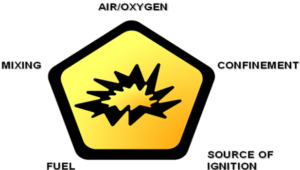The recent Antwerp port explosion and fire on the 26th February 2016, which occurred in a bunker where flammable wastes were stored, reminds us of the importance of ATEX Regulations when dealing with anywhere that an explosive atmosphere may occur.
Extensive damage was caused to the waste management facility but fortunately there were no serious injuries or fatalities. The cause or causes of this explosion and subsequent fire currently is unknown and the Belgium Authorities are investigating. At the Antwerp waste management facility, highly flammable and flammable liquid wastes would have been stored in large quantities in tanks, IBCs, drums and containers.
Obviously the investigation will focus on the flammable substances involved in the explosion, how and what led to an explosive mixture within the explosive ranges, potential ignition sources that ignited this flammable mixture and the site’s safety management systems, procedures and resources.
Flammable liquid waste poses an explosion and fire hazard. Gases, vapours, mists and dusts are all flammable substances which under certain atmospheric conditions have the potential to cause an explosion.
An explosion occurs if a flammable substance is present in mixture with air or another oxidant (i.e. sufficient oxygen), within the explosion limits, together with a source of ignition. In addition, if the vapour, gas or dust cloud is contained, the rapid release of heat and gas causes a pressure rise or over-pressure explosion.

For explosions to occur the fuel to air ratio (%) has to be in a range, between the Lower Explosive Limit or LEL and the Upper Explosive Limit, known as UEL.
– Lower Explosive Limit (LEL) – if the fuel to air ratio is too small the mixture will not ignite, not enough fuel in the mixture to support combustion.
– Upper Explosive Limit (UEL) – if the fuel to air ratio is too large the mixture will not ignite, saturated fuel mixture, reduced oxygen.
Flammability Limits can change with the Oxygen levels, Temperature and Pressure, as below:
- Oxygen enrichment decreases the LEL and increases the UEL.
- For Higher Temperature, LEL is lower and UEL is increased.
- Increase of Pressure, will increase both LEL and UEL.
Flammable substances include:
- Petrol
- Liquefied petroleum gas (LPG)
- Paint/varnish
- Solvents
- Flammable liquid waste
- Dust which when mixed with air could cause an explosive atmosphere, i.e. Dust from milling and sanding operations
Due to the potential for an explosive atmosphere, hazardous ar ea classification (ATEX Zoning) is used to identify where special precautions are required to prevent sources of ignition. Areas where an explosion hazard is present must be clearly identified using appropriate prescribed warning signage.
ea classification (ATEX Zoning) is used to identify where special precautions are required to prevent sources of ignition. Areas where an explosion hazard is present must be clearly identified using appropriate prescribed warning signage.
Did you know?
Hazardous places are classified in terms of zones. These zones are based on how often and for how long the explosive atmosphere occurs.
| ATEX Zone |
|
Examples | |
|---|---|---|---|
|
Zone 0 Zone 20 |
Where an explosive atmosphere is continuously present, or present for long periods (> 100 hours per year) | Vapour zone of an Ethanol storage tank (zone 0) | |
| Zone 1
Zone 21 |
Where an explosive atmosphere is likely to occur in normal operation (10- 100 hours per year). | Zone around vents of the Ethanol tank (zone 1)
Dirty side of a filter unit (zone 21) |
|
| Zone 2
Zone 22 |
Where an explosive atmosphere is not likely to occur in normal operation and if it does occur it will exist only for a short time (< 10 hours per year) | Zone around a gas storage compound (zone 2)
Around a fluid bed dryer (zone 22) |
The General Principles of the ATEX Directive
The employer shall take technical and/or organisational measures appropriate to the nature of the operation, in order of priority and in accordance with the following basic principles;
- The prevention of the formation of explosive atmospheres, or where the nature of the activity does not allow that,
- The avoidance of the ignition of explosive atmospheres, and
- The mitigation of the detrimental effects of an explosion so as to ensure the health and safety of workers.
Your Legal Requirements as an Employer- Risk Assessment based approach
- You must identify work area where hazardous dangerous explosive substances are used, stored and handled
- Are dangerous substances used, stored and/or generated?
- Are potential hazardous scenarios and activities present?
- Can the dangerous substance be released?
- Can the release result in explosive atmosphere?
- Are ignition sources present?
- Determine the impact of fire or explosion
- You must conduct explosion safety risk assessments to identify the hazards and risks, rate the risk in terms of likelihood and consequence
- You must take organisational and / or technical measures to eliminate or control the explosion hazard in order of priority and document the measures in an Explosion Protection Document (EPD)
- You must classify the work area in to zones based on the likelihood of an explosive atmosphere been present
- There are special requirements with respect to the selection of work equipment for use in ATEX classified areas
- Duty to coordinate where other companies operate in the same workplace
For more information on ATEX Consultancy please do not hesitate to contact our Consultants by email at info@occupli.com or by phone at 021 4978100.
Occupli Consultancy provides an ATEX consultancy, training and support service to our clients nationwide. We have extensive ATEX experience and a proven track record in providing these services across many industrial sectors.
